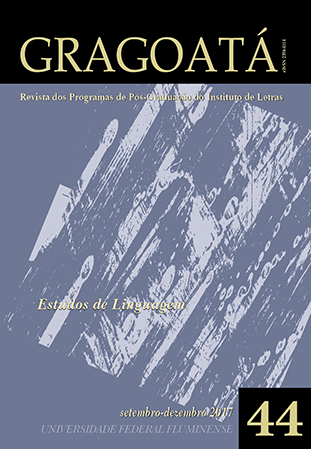Semiotics and Discourse Studies
DOI:
https://doi.org/10.22409/gragoata.v22i44.33548Palabras clave:
Discourse studies. Semiotic. Academic discourse. Greimas.Resumen
In this paper, I would like to discuss the contribution that post-structuralist semiotics has brought to the analysis of academic discourse. The semiotic model was developed initially for the analysis of tales and myths. It has been gradually extended to various forms of fiction (novels, short stories), and then, according to "a growing degree of complexity and abstraction", to all "forms of social production of meaning" (p. 5). This is the project stated in the first pages to a book entitled “Introduction to Discourse Analysis in Social Sciences” (A.J. Greimas & E. Landowski eds, 1979). The generalized extension is based on a typology of discourses that has been illustrated by specific analyses published in the 1980s (Bastide 1981, Bastide & Fabbri 1985, Landowski 1986, Bordron 1987). One may be considered that the research project led by Greimas and Landowski is thus located at the farthest point of development and initial application of the model and it is therefore a test for the narrative hypothesis. In doing so, the semiotic approach took the risk of being confronted with other models of analysis, such as they were elaborated in theoretical frameworks resulting from rhetoric (renewed in the 1950s by Chaim Perelman and his school ), pragmatics (cf Parret 1983 & 1987), sociology of knowledge (from the founding work of Berger & Luckmann 1966), or as they relate to other theoretical currents in the language sciences (in particular, In France, the Althusserian discourse analysis). For the discourse in social sciences, these models offer two advantages over that of semiotics: on the one hand, it seems that the theoretical postulates on which they are worked out are more directly in accord with this type of discourse; on the other hand, they can count on a solid tradition of studies to ensure the sustainability of the results. Nevertheless, the model of semiotic analysis is original and it has also an advantage: it is general. I will put forward the benefits of this generality.
---
DOI: http://dx.doi.org/10.22409/gragoata.2017n44a1033
Descargas
##submission.downloads##
Publicado
Cómo citar
Número
Sección
Licencia
AUTORIZAÇÃO
Autores que publicam em Gragoatá concordam com os seguintes termos:
Os autores mantêm os direitos e cedem à revista o direito à primeira publicação, simultaneamente submetido a uma licença Creative Commons Atribuição 4.0 Internacional (CC BY 4.0), que permite o compartilhamento por terceiros com a devida menção ao autor e à primeira publicação pela Gragoatá.
Os autores podem entrar em acordos contratuais adicionais e separados para a distribuição não exclusiva da versão publicada da obra (por exemplo, postá-la em um repositório institucional ou publicá-la em um livro), com o reconhecimento de sua publicação inicial na Gragoatá.
A Gragoatá utiliza uma Licença Creative Commons - Atribuição CC BY 4.0 Internacional.











